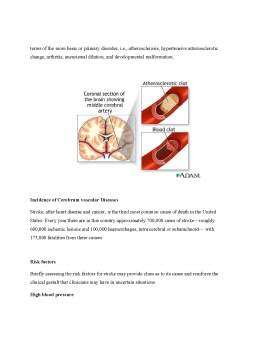Extras din proiect
Among all the neurologic diseases of adult life, the cerebrum vascular ones clearly rank first in frequency and importance. At least 50 percent of the neurologic disorders in a general hospital are of this type. At some time or other, every physician will be required to examine patients with cerebrum vascular disease and should at least know something of the common types—particularly those in which there is a reasonable prospect of successful medical or surgical intervention or the prevention of recurrence. There is another advantage to be gained from the study of this group of diseases— namely, that they have traditionally provided one of the most instructive approaches to neurology.
It must also be noted that, in the last two decades, new and extraordinary types of imaging technology have been introduced that allow the physician to make physiologic distinctions between normal, ischemic, and infracted brain tissue. This bio pathologic approach to stroke will likely guide the next generation of treatments and has already had a pronounced impact on the direction of research in the field. Salvageable brain tissue to be protected in the acute phase of stroke can be delineated by these methods. To identify this ischemic but not yet infracted tissue virtually defines the goal of modern stroke treatment. Which of the sophisticated imaging techniques will contribute to improved clinical outcome is still to be determined, but certain ones, such as diffusion weighted imaging, have already proved invaluable in stroke work.
The term cerebrum vascular disease designates any abnormality of the brain resulting from a pathologic process of the blood vessels. Pathologic process is given an inclusive meaning—namely, occlusion of the lumen by embolus or thrombus, rupture of a vessel, an altered permeability of the vessel wall, or increased viscosity or other change in the quality of the blood flowing through the cerebral vessels. The vascular pathologic process may be considered not only in its grosser aspects—embolism, thrombosis, dissection, or rupture of a vessel—but also in terms of the more basic or primary disorder, i.e., atherosclerosis, hypertensive arteriosclerotic change, arthritis, aneurismal dilation, and developmental malformation.
Incidence of Cerebrum vascular Diseases
Stroke, after heart disease and cancer, is the third most common cause of death in the United States. Every year there are in this country approximately 700,000 cases of stroke—roughly 600,000 ischemic lesions and 100,000 haemorrhages, intra cerebral or subarachnoid— with 175,000 fatalities from these causes.
Risk factors
Briefly assessing the risk factors for stroke may provide clues as to its cause and reinforce the clinical gestalt that clinicians may have in uncertain situations.
High blood pressure
A major risk factor common to both coronary heart disease and stroke, high blood pressure is present in 50 to 70 percent of stroke cases, depending primarily on the type of stroke. The long-term effects of the increased pressure damage the walls of the arteries, making them more vulnerable to thickening or narrowing (atherosclerosis) or rupture.
There is no specific blood pressure reading that is considered normal, but rather a range. Most experts agree, however, that a reading greater than 140 /90 mm Hg is abnormal and anyone with such a reading should see a physician. But even mild elevations in blood pressure are associated with an increased risk for stroke. Sometimes mildly elevated blood pressure can be controlled by life-style modification, but medication is often needed. Although the patient may feel no different, control of blood pressure is associated with a marked decrease in the occurrence of stroke.
Heart diseases
Just as strokes area strong risk factor for heart disease, heart disease is a strong risk factor for stroke, although only for one type of stroke, ischemic strokes.
Heart disease is associated with stroke in two ways. First, damage to the heart (as, for example, from a heart attack) may make it more likely that clots will form within the heart. These clots can break loose and travel to the brain, causing a cardio embolic stroke. Heart disease and stroke are also associated because they are both manifestations of atherosclerotic disease in the blood vessels. If the blood vessels feeding the heart (the coronary arteries) are diseased, it is likely that arteries to the brain are also affected.
Preview document
Conținut arhivă zip
- Cerebrovascular Diseases - Stroke.doc











































